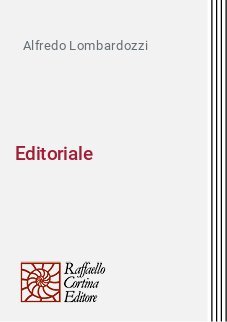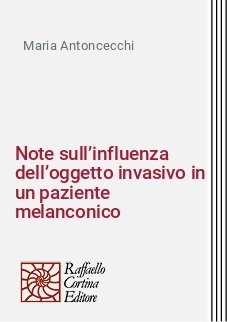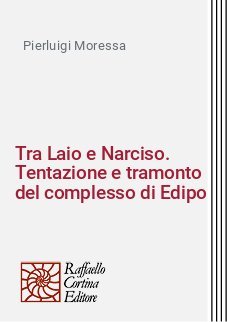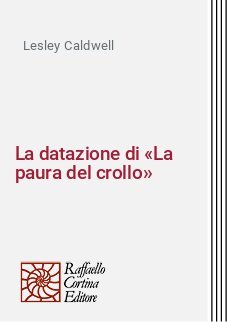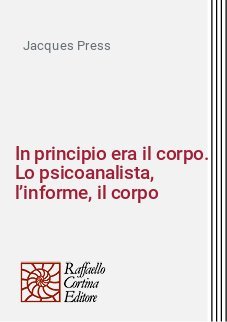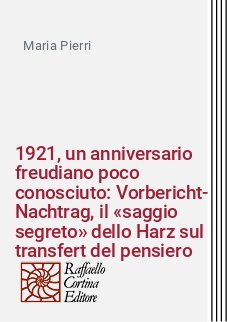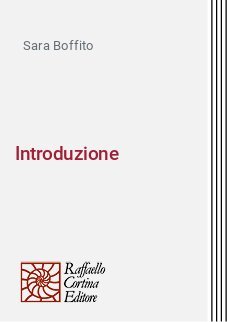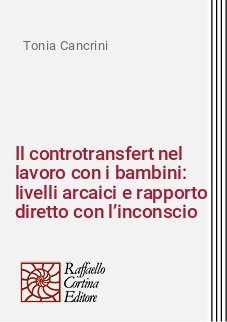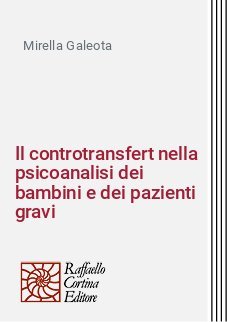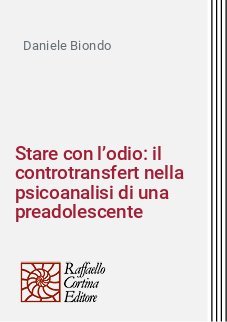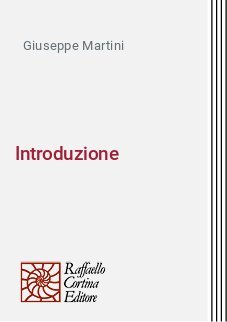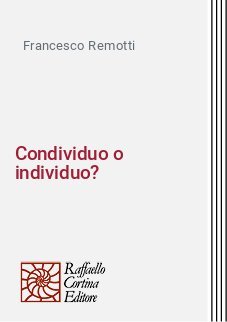Raffaello Cortina Editore
Editoriale
rivista: La Rivista di Psicoanalisi
fascicolo: Rivista di Psicoanalisi 2021/3
di Alfredo Lombardozzi
Note sull’influenza dell’oggetto invasivo in un paziente melanconico
rivista: La Rivista di Psicoanalisi
fascicolo: Rivista di Psicoanalisi 2021/3
di Maria Antoncecchi
NOTE SULL’INFLUENZA DELL’OGGETTO INVASIVO IN UN PAZIENTE MELANCONICO
Il lavoro intende descrivere come la relazione con un oggetto con caratteristiche invasive possa modificare i normali processi di sviluppo generando dolore, frammentazione e stati di confusione. Questa specifica esperienza, nelle prime fasi della vita, comporta l’incorporazione forzata di parti dell’ oggetto che vanno a confondersi con il Sé non ancora formato del bambino che si sente costantemente minacciato dalla presenza di oggetti alieni. Attraverso il caso clinico, l’A. vuole mettere in evidenza il complesso lavoro di differenziazione tra il Sé del paziente e l’oggetto invasivo e la costruzione di un ambiente affettivo sicuro che ha permesso di restituire un senso all’ esistenza del paziente.
PAROLE CHIAVE: Arresto dello sviluppo, identificazione patologica, melanconia, oggetto invasivo.
Notes on the influence of the invasive object in a melancholic patient. This contribution explores how a relationship with an object with invasive characteristics must impeded the normal developmental processes generating pain, fragmentation and confusion. This specific experience, in the early stages of life, involves the forced incorporation of parts of the object which become confused with the self not yet formed by the infant who constantly feels threatened by the presence of foreign objects. The patient I shall describe in the clinical case shows the complex work of differentiation between the patient’s self and the invasive object and the construction of a safe affective environment which allows at restoring meaning to the existence of the patient.
KEY WORDS: Impeded development, invasive object, melancholy, pathologic identification.
Notes sur l’influence de l’objet invasif chez un patient mélancolique. Le travail entend décrire comment la relation avec un objet aux caractéristiques invasives peut modifier les processus normaux de développement, générant douleur, fragmentation et états de confusion. Cette expérience spécifique, dans les premiers stades de la vie, implique l’incorporation forcée de parties de l’objet qui se confondent avec le moi non encore formé de l’enfant qui se sent constamment menacé par la présence d’objets étrangers. A travers le cas clinique, l’Auteur veut mettre en évidence le travail complexe de différenciation entre le Soi du patient et l’objet invasif et la construction d’un environnement émotionnel sécurisant qui a permis de redonner un sens à l’existence du patient.
MOTS-CLÉS: Arrêt du développement, identification pathologique, mélancolie, objet invasif.
Notas sobre la influencia del objeto invasivo en un paciente melancólico. El trabajo intenta describir cómo la relación con un objeto de características invasivas puede modificar los procesos normales de desarrollo, generando dolor, fragmentación y estados de confusión. Esta experiencia específica, en las primeras etapas de la vida, implica la incorporación forzada de partes del objeto que se fusionan con el Self aún no formado del niño que se siente constantemente amenazado por la presencia de objetos extraños. A través del caso clínico, el A. quiere resaltar el complejo trabajo de diferenciación entre el Self del paciente y el objeto invasor y la construcción de un ambiente afectivo seguro que ha permitido devolverle sentido a la existencia del paciente.
PALABRAS CLAVE: Detención del desarrollo, identificación patológica, melancolía, objeto invasor.
Anmerkungen zum Einfluss des invasiven Objekts bei einem melancholischen Patienten. Die Arbeit beabsichtigt zu beschreiben, wie die Beziehung zu einem Objekt mit invasiven Eigenschaften die normalen Entwicklungsprozesse verändern und dabei Schmerz, Fragmentierung und Verwirrungszustände hervorrufen kann. Diese spezifische Erfahrung in den ersten Lebensphasen bringt die erzwungene Inkorporation von Teilen des Objekts mit sich, die mit dem noch ungeformten Selbst des Kindes durcheinandergeraten, das sich unaufhörlich von der Präsenz fremder Objekte bedroht fühlt. Vermittels eines klinischen Falls will die Verfasserin die komplexe Arbeit der Differenzierung zwischen dem Selbst des Patienten und dem invasiven Objekt sowie den Aufbau einer sicheren emotionalen Umgebung hervorheben, die es erlaubt hat, der Existenz des Patienten einen Sinn zu geben.
SCHLÜSSELWÖRTER: Entwicklungsstillstand, pathologische Identifizierung, Melancholie, invasives Objekt.
Tra Laio e Narciso. Tentazione e tramonto del complesso di Edipo
rivista: La Rivista di Psicoanalisi
fascicolo: Rivista di Psicoanalisi 2021/3
di Pierluigi Moressa
TRA LAIO E NARCISO. TENTAZIONE E TRAMONTO DEL COMPLESSO DI EDIPO
L’autore esplora l’evoluzione del complesso di Edipo: dal suo evitamento alla tentazione fino al tramonto. Descrive i punti di vista espressi da autori diversi e impiega l’analisi del mito confrontandola con un caso clinico.
PAROLE CHIAVE: Colpa, complesso edipico, mito.
Between Laius And Narcissus. Temptation and dissolution of the oedipal complex. The author explores the evolution of the oedipal complex: from avoidance to temptation until dissolution. He describes viewpoints expressed by different authors and uses the analysis of the myth comparing it to a clinical case.
KEYWORDS: Guilt, myth, oedipal complex.
Entre Laïos et Narcisse. Tentation et coucher de soleil du complexe d’Œdipe. L’auteur explore l’évolution du complexe d’Œdipe : de son évitement à la tentation jusqu’au coucher du soleil. Il décrit les points de vue exprimés par différents auteurs et utilise l’analyse du mythe en le comparant à un cas clinique.
MOTS-CLÉS: Culpabilité, complexe d’Œdipe, mythe.
Entre Layo y Narciso. Tentación y final del complejo de Edipo. El autor explora la evolución del complejo de Edipo: desde su evitación hacia la tentación hasta el final del mismo. Describe los puntos de vista expresados por diferentes autores y emplea el análisis del mito en relación con un caso clínico.
PALABRAS CLAVE: Culpa, complejo de Edipo, mito.
Zwischen Laios und Narziss. Versuchung und Untergang des Ödipuskomplexes. Der Verfasser untersucht die Entwicklung des Ödipuskomplexes: von seiner Vermeidung über seine Versuchung bis hin zu seinem Untergang. Er beschreibt die Standpunkte verschiedener Autoren und nutzt die Analyse des Mythos in der Gegenüberstellung mit einem klinischen Fall.
SCHLÜSSELWÖRTER: Schuld, Ödipuskomplex, Mythos.
La datazione di «La paura del crollo»
rivista: La Rivista di Psicoanalisi
fascicolo: Rivista di Psicoanalisi 2021/3
di Lesley Caldwell
LA DATAZIONE DI «LA PAURA DEL CROLLO»
Seguendo l’affermazione di Clare Winnicott (1974) che «Fear of breakdown», «La paura del crollo», sia stato uno degli ultimi lavori scritti da Winnicott, André́ Green (2014) e Thomas Ogden (2014) sostengono entrambi che il 1970-71 sia la data dell’articolo. Sulla base di altri lavori del periodo 1960-1965, disponibili in Complete works of Donald Winnicott (OUP, 2016), questo articolo suggerisce invece che la datazione precedente, 1963?, proposta dai curatori di Esplorazioni psicoanalitiche (1989) sia quella corretta. L’autore condivide l’ampliamento del tema dell’articolo proposto da Thomas Ogden e fornisce una vignetta clinica.
PAROLE CHIAVE: André Green, follia, Paura del crollo, Thomas Ogden.
The dating of «The Fear of Collapse». Following Clare Winnicott’s claim ( 1974) that «Fear of breakdown» was among Winnicott’s last works, André Green (2014) and Thomas Ogden (2014) argue for 1970-71 as the date of the paper. On the basis of other work from the period 1960-1965, available in The Complete works of Donald Winnicott (OUP, 2016), this article proposes that the earlier date, 1963? proposed by the volume editors of Psychoanalytic Explorations (1989) is the correct one. It endorses the broadening of the paper’s theme in Thomas Ogden’s article and gives a clinical vignette.
KEY WORDS: André Green, Fear of breakdown, madness, Thomas Ogden.
La datation de «La peur de l’effondrement». Suite à la déclaration de Clare Winnicott (1974) selon laquelle il s’agissait de l’une des dernières œuvres de Winnicott, André Green (2014) et Thomas Ogden (2014) soutiennent que 1970-71 est la date de l’article «Fear of Breaking». S’appuyant sur d’autres œuvres de la période 1960-1965, disponibles dans œuvres complètes de Donald Winnicott (OUP, 2016), cet article propose que la date précédente, 1963? proposée par les éditeurs du volume des Explorations psychanalytiques (1989) est la bonne. Il approuve le thème élargi de l’article de Thomas Ogden et fournit une vignette clinique.
MOTS-CLÉS: André Green, folie, peur de l’effondrement, Thomas Ogden.
la datación de «El miedo al derrumbe». Siguiendo la afirmación de Clare Winnicott (1974) de que ««Miedo al derrumbe»» fue una de las últimas obras de Winnicott, André Green (2014) y Thomas Ogden (2014) sostienen que 1970-71 es la fecha del artículo. Basado en otras obras del período 1960-1965, disponibles en Obras completas de Donald Winnicott (OUP, 2016), este artículo propone que la fecha anterior, 1963? propuesta por los editores del volumen de Psychoanalytic Explorations (1989) sea la fecha correcta. Aprueba el tema ampliado del artículo de Thomas Ogden e incluye una viñeta clínica.
PALABRAS CLAVE: André Green, locura, Miedo al colapso, Thomas Ogden.
Die Datierung von «Die Angst vor dem Zusammenbruch». Der Behauptung Clare Winnicotts (1974) folgend, dass es sich um eine von Winnicotts letzten Arbeiten handele, erklären André Green (2014) und Thomas Ogden (2014), dass der Artikel «Fear of breakdown» auf 1970-71 zu datieren sei. Auf der Grundlage anderer Arbeiten aus der Zeit von 1960 bis 1965, die in den Complete works of Donald Winnicott (OUP, 2016) verfügbar sind, schlägt dieser Beitrag vor, dass die frühere Datierung auf 1963, die von den Herausgebern des Bandes Psychoanalytic Explorations (1989) vorgeschlagen wurde, die richtige ist. Er stimmt der Erweiterung des Themas im Artikel von Thomas Ogden zu und liefert eine klinische Vignette.
SCHLÜSSELWÖRTER: André Green, Wahnsinn, Angst vor dem Zusammenbruch, Thomas Ogden.
In principio era il corpo. Lo psicoanalista, l’informe, il corpo
rivista: La Rivista di Psicoanalisi
fascicolo: Rivista di Psicoanalisi 2021/3
di Jacques Press
IN PRINCIPIO ERA IL CORPO. LO PSICOANALISTA, L’INFORME, IL CORPO
Dopo aver sottolineato ciò che il lavoro deve alle elaborazioni dello Working Party sulla Psicosomatica della Federazione Europea di Psicoanalisi, l’autore sviluppa le sue riflessioni a partire dal celebre verso di Goethe Im Anfang war die Tat (In Principio era l’Atto) e dal brano del primo Faust da cui è tratto. Secondo l’autore, prima ancora dell’atto, è il corpo che è «In principio». È sempre dal corpo che si dipartono, a partire dall’informe, i primi abbozzi di psichicizzazione. Due esempi clinici illustrano questo punto di vista.
PAROLE CHIAVE: Atto, corpo e mente, informe, malattie somatiche e psicoanalisi.
At the beginning was the body. The psychoanalyst, formlessness and the body. After highlighting what the paper owes to elaboration in the Working Party on Psychosomatics of the European Psychoanalytic Federation, the author develops his reflection starting from the famous verse by Goethe «Im Anfang war die Tat (In the beginning was the Deed) and on the passage from the first Faust where it is contained. For the author, it is the body, even more than the deed, which is «in the beginning». It is also from the body that the first formless buds of psychic life develop. Two clinical examples illustrate this point of view.
KEY WORDS: Body and psyche, deed, formlessness, somatic illnesses and psychoanalysis.
Au commencement était le corps. Le psychanalyste, l'informe, le corps. Après avoir souligné ce que son travail doit aux réflexions de la Working Party on Psychosomatics de la Fédération Européenne de Psychanalyse, l’auteur développe sa réflexion en se fondant sur le vers célèbre de Goethe Im Anfang war die Tat (Au commencement était le corps. Le psychanalyste, l’informe, le corps) et sur le passage du premier Faust dont il est issu. Pour lui, plus encore que l’acte, c’est le corps qui est «au début». C’est aussi à partir de lui que prennent, à partir de l’informe, les premières ébauches de psychisation. Deux exemples cliniques illustrent son point de vue.
MOTS CLÉS: Acte, action, corps et psyché, informe, maladies somatiques et psychanalyse.
Al principio fue el cuerpo. El psicoanalista, lo informe, el cuerpo. Tras subrayar lo que el presente trabajo debe a las elaboraciones del Working Party de Psicosomática de la Federación Europea de Psicoanálisis, el autor desarrolla sus reflexiones a partir del célebre verso de Goethe Im Anfang war die Tat (En Principio era el acto) y del pasaje del primer Fausto del que se toma. Según el autor, incluso antes del acto, es el cuerpo el que está «al principio». Siempre es del cuerpo de donde parten los primeros esbozos de psiquización, partiendo de lo informe. Dos ejemplos clínicos ilustran este punto de vista.
PALABRAS CLAVE: Acto, cuerpo y mente, informe, enfermedades somáticas y psicoanálisis.
Im Anfang war der Körper. Der Psychoanalytiker, das Formlose, der Körper. Nachdem der Verfasser unterstrichen hat, was die Arbeit den Ausführungen der Arbeitsgruppe Psychosomatik der Europäischen Psychoanalytischen Föderation verdankt, entwickelt er seine Überlegungen ausgehend von Goethes berühmtem Vers «Im Anfang war die Tat» und der Passage des Faust I, der dieser entstammt. Dem Verfasser zufolge ist es noch vor der Tat der Körper, der «im Anfang» steht. Immer ist es der Körper, von dem die ersten Andeutungen der Psychisierung ausgehen, vom Formlosen an. Zwei klinische Beispiele verdeutlichen diesen Standpunkt.
SCHLÜSSELWÖRTER: Akt, Körper und Geist, Formloses, körperliche Krankheiten und Psychoanalyse.
1921, un anniversario freudiano poco conosciuto: Vorbericht-Nachtrag, il «saggio segreto» dello Harz sul transfert del pensiero
rivista: La Rivista di Psicoanalisi
fascicolo: Rivista di Psicoanalisi 2021/3
di Maria Pierri
1921, UN ANNIVERSARIO FREUDIANO POCO CONOSCIUTO: VORBERICHT-NACHTRAG. IL «SAGGIO SEGRETO» DELLO HARZ SUL TRANSFERT DEL PENSIERO
Vorbericht-Nachtrag (Premessa-Poscritto, 1921), scritto da Freud in due tempi e in due manoscritti separati, pare mantenere non integrate le riflessioni sulla lettura del pensiero nel lavoro degli indovini – le tre profezie «non avverate» – e quelle sul transfert del pensiero in analisi -il caso «Forsyth». Sono riferite le circostanze di questo saggio, che servirà da bozza per la Lezione XXX «Sogno e Occultismo» (1932) e i destini dei due manoscritti: il primo pubblicato postumo, cui fu arbitrariamente attribuito il titolo di «Psicoanalisi e Telepatia» e il secondo dato per scomparso e ritrovato solo recentemente. Questo saggio segreto e occulto contiene profonde intuizioni sulla comunicazione inconscia: dal lavoro di controtransfert – l’analista-indovino come lastra sensibile alla luce –, al linguaggio segreto del setting fino ad arrivare al linguaggio originario madre-bambino.
PAROLE CHIAVE: Linguaggio segreto, telepatia, transfert del pensiero.
1921, a little-known Freudian anniversary: Vorbericht-Nachtrag. Harz’s «secret essay» on transference of thought. Freud’s Vorbericht-Nachtrag (Foreword-Postscript, 1921), written in two times and in two separate manuscripts, seems to keep not integrated the reflections on mind reading in the work of soothsayers – the three «not fulfilled» prophecies – and those on thought transference in analysis – the «Forsyth» case. The circumstances of this essay are reported, which will serve as a draft for Lecture XXX «Dream and Occultism» (1932), and the destinies of the two manuscripts: the first published posthumously, which was arbitrarily attributed the title of «Psychoanalysis and Telepathy» and the second reported missing and found only recently. This secret and occult essay contains profound insights into unconscious communication: from the work of countertransference – the analyst-fortune teller as a light-sensitive plate –, to the secret language of the setting up to the original mother-child language.
KEY WORDS: Telepathy, thought transference, secret language.
1921, un anniversaire freudien méconnu: Vorbericht-Nachtrag. «l’essai secret» du Harz sur le transfert de la pensée. Vorbericht-Nachtrag (Premise-Postscript, 1921), écrit par Freud en deux temps et en deux manuscrits séparés, semble garder les réflexions sur la lecture de l’esprit dans les travaux des devins – les trois prophéties «non accomplies» – et celles sur le transfert non intégré de la pensée dans l’analyse – le cas «Forsyth». Les circonstances de cet essai sont rapportées, qui serviront de brouillon à la Leçon XXX «Rêve et Occultisme» (1932) et les destinées des deux manuscrits: le premier publié à titre posthume, auquel le titre de «Psychanalyse et Télépathie» a été arbitrairement attribué, et le second a été porté disparu et n’a été trouvé que récemment. Cet essai secret et occulte contient des éclairages profonds sur la communication inconsciente : du travail de contretransfert – l’analyste-devin comme plaque sensible à la lumière –, au langage secret du setting, jusqu’au langage mère-enfant originel.
Mots-clés: Langage secret, télépathie, transfert de la pensée.
1921, un aniversario freudiano poco conocido: Vorbericht-Nachtrag. el «ensayo secreto» del Harz sobre la transferencia del pensamiento. Vorbericht-Nachtrag (Premisa-Posdata, 1921), escrito por Freud en dos ocasiones y en dos manuscritos separados, parece mantener no integradas las reflexiones sobre la lectura de la mente en el trabajo de los adivinos – las tres profecías «no cumplidas» – con las de la transferencia del pensamiento en el análisis - el caso «Forsyth». Se relatan las circunstancias de este ensayo, que servirá de borrador para la Lección XXX «Sueño y Ocultismo» (1932) y los destinos de los dos manuscritos: el primero publicado póstumamente, al que se le atribuyó arbitrariamente el título de «Psicoanálisis y Telepatía» y el segundo considerado desaparecido y encontrado recientemente. Este ensayo secreto y oculto contiene profundas intuiciones sobre la comunicación inconsciente: desde el trabajo de la contratransferencia (el analista-adivino como una placa sensible a la luz), hasta el lenguaje secreto del setting, hasta llegar al lenguaje original de madre e hijo.
Palabras clave: Lenguaje secreto, telepatía, transferencia de pensamientos.
1921, ein wenig bekanntes Freud’sches Jubiläum: Vorbericht-Nachtrag. der «geheime Aufsatz» von der Harzreise über die Gedankenübertragung. Vorbericht-Nachtrag (1921), von Freud zu zwei unterschiedlichen Zeitpunkten und in zwei getrennten Manuskripten verfasst, scheint die Überlegungen zum Gedankenlesen in der Arbeit von Wahrsagern – die drei «unerfüllten Prophezeiungen» – und diejenigen zur Gedankenübertragung in der Analyse – der Fall «Forsyth» – getrennt zu halten. Es werden die Umstände dieses Aufsatzes, der als Entwurf für die XXX. Vorlesung «Traum und Okkultismus» (1932) diente, sowie das Schicksal der beiden Manuskripte dargestellt: das erste, das postum veröffentlicht wurde und dem willkürlich der Titel «Psychoanalyse und Telepathie» zugewiesen wurde, und das zweite, das als verschollen galt und erst kürzlich gefunden wurde. Dieser geheime und okkulte Aufsatz enthält profunde Einsichten in die unbewusste Kommunikation: von der Arbeit der Gegenübertragung – der Analytiker-Wahrsager als lichtempfindliche Platte –, bis hin zur Geheimsprache des Settings und der Ursprache zwischen Mutter und Kind.
Schlüsselwörter: Geheimsprache, Telepathie, Gedankenübertragung.
Introduzione
rivista: La Rivista di Psicoanalisi
fascicolo: Rivista di Psicoanalisi 2021/3
di Sara Boffito
Il controtransfert nel lavoro con i bambini: livelli arcaici e rapporto diretto con l’inconscio
rivista: La Rivista di Psicoanalisi
fascicolo: Rivista di Psicoanalisi 2021/3
di Tonia Cancrini
Il controtransfert nel lavoro con i bambini: livelli arcaici e rapporto diretto con l’inconscio
La dinamica del transfert e del controtransfert è fondamentale per la psicoanalisi dei bambini e dei pazienti gravi. Quale sia la rilevanza del controtransfert nella relazione psicoanalitica è ben noto da quando Paula Heimann mise in luce l’importanza del controtransfert come aiuto fondamentale per entrare in contatto con l’inconscio del paziente e con i livelli primitivi dell’esperienza. Il controtransfert ha acquisito sempre più importanza all’interno della scuola kleiniana, e non solo. Ricordiamo tra gli altri Hanna Segal, Rosenfeld, Bion, Racker, Winnicott. Con i bambini e con i pazienti gravi è fondamentale cogliere i livelli di comunicazione non verbale. L’analista è quindi chiamato a tener conto dei propri sentimenti, delle proprie sensazioni e quindi del proprio controtransfert. Infatti affetti inesprimibili e invivibili per il paziente, situazioni di alta conflittualità prendono corpo ed espressione soltanto attraverso la mediazione del controtransfert dell’analista.
PAROLE CHIAVE: Controtransfert, identificazione proiettiva, inconscio, livelli primitivi, transfert.
Countertransference in working with children: archaic levels and direct relationship with the unconscious. The dynamics of transference and countertransference are fundamental to the psychoanalysis of children and severe patients. The relevance of countertransference in the psychoanalytic relationship is well known since Paula Heimann highlighted the importance of countertransference as a fundamental aid to get in touch with the patient’s unconscious and with the primitive levels of experience. Countertransference has become increasingly important within the Kleinian school and beyond. We recall among others Hanna Segal, Rosenfeld, Bion, Racker, Winnicott. With children and severe patients it is fundamental to grasp the levels of non-verbal communication. The analyst is therefore called to take into account his/her own feelings, sensations and therefore countertransference. In fact inexpressible and unlivable affections for the patient, situations of high conflict take shape and expression only through the mediation of the analyst’s countertransference.
KEYWORDS: Countertransference, primitive levels, projective identification, transference, unconscious.
Le contre-transfert dans le travail avec les enfants : niveaux archaïques et relation directe avec l’inconscient. La dynamique transférentielle et contre-transférentielle est fondamentale pour la psychanalyse des enfants et des patients gravement malades. Quelle est la pertinence du contretransfert dans la relation psychanalytique est bien connue depuis que Paula Heimann a souligné l’importance du contretransfert comme aide fondamentale pour entrer en contact avec l’inconscient du patient et avec les niveaux primitifs de l’expérience. Le contre-transfert a acquis de plus en plus d’importance au sein de l’école kleinienne, et au-delà. On se souvient entre autres de Hanna Segal, Rosenfeld, Bion, Racker, Winnicott. Avec les enfants et les patients gravement malades, il est essentiel de comprendre les niveaux de communication non verbale. L’analyste est donc appelé à prendre en compte ses propres sentiments, ses propres sensations et donc son propre contretransfert. En effet, les affects inexprimables et invivables pour le patient, les situations de haut conflit ne prennent forme et expression que par la médiation du contre-transfert de l’analyste.
MOTS-CLÉS: Contre-transfert, identification projective, inconscient, niveaux primitifs, transfert.
La contratransferencia en el trabajo con niños: niveles arcaicos y relación directa con el inconsciente. La dinámica de la transferencia y de la contratransferencia es fundamental para el psicoanálisis de niños y pacientes graves. La relevancia de la contratransferencia en la relación psicoanalítica es bien conocida desde que Paula Heimann destacó la importancia de la contratransferencia como ayuda fundamental para entrar en contacto con el inconsciente del paciente y con niveles primitivos de la experiencia. La contratransferencia ha adquirido cada vez más importancia no solamente dentro de la escuela kleiniana. Recordamos entre otros autores Hanna Segal, Rosenfeld, Bion, Racker, Winnicott. Con niños y con pacientes graves es fundamental comprender los niveles de comunicación no verbal. Por lo tanto, el analista tiene que tener en cuenta sus propios sentimientos, sus propias sensaciones y, por tanto, su propia contratransferencia. De hecho, afectos inexpresables e invivibles para el paciente, situaciones de alto conflicto toman forma y expresión sólo a través de la mediación de la contratransferencia del analista.
PALABRAS CLAVE: Contratransferencia, identificación proyectiva, inconsciente, niveles primitivos, transferencia.
Die Gegenübertragung in der Arbeit mit Kindern: archaische Ebenen und direkte Beziehung zum Unbewussten. Die Dynamik von Übertragung und Gegenübertragung ist für die Psychoanalyse von Kindern und schwierigen Patienten wesentlich. Worin die Relevanz der Gegenübertragung in der psychoanalytischen Beziehung besteht, ist bekannt, seit Paula Heimann die Bedeutung der Gegenübertragung als grundlegendes Hilfsmittel zur Kontaktaufnahme mit dem Unbewussten des Patienten und mit den Urebenen der Erfahrung hervorgehoben hat. Die Gegenübertragung hat innerhalb der Kleinianischen Schule, und darüber hinaus, zunehmend an Bedeutung gewonnen. Wir erinnern unter anderem an Hanna Segal, Rosenfeld, Bion, Racker, Winnicott. Bei Kindern und schwierigen Patienten ist es entscheidend, die Ebenen der nonverbalen Kommunikation zu erfassen. Der Analytiker ist daher aufgerufen, die eigenen Gefühle, Empfindungen und damit die eigene Gegenübertragung zu berücksichtigen. Tatsächlich nehmen für den Patienten unaussprechliche und unerträgliche Affekte, konfliktreiche Situationen, lediglich durch die Vermittlung der Gegenübertragung des Analytikers Gestalt und Ausdruck an.
SCHLÜSSELWÖRTER: Gegenübertragung, projektive Identifizierung, Unbewusstes, Urebenen, Übertragung.
Il controtransfert nella psicoanalisi dei bambini e dei pazienti gravi
rivista: La Rivista di Psicoanalisi
fascicolo: Rivista di Psicoanalisi 2021/3
di Mirella Galeota
Il controtransfert nella psicoanalisi dei bambini e dei pazienti gravi
Il controtransfert (CT) è certamente un utile strumento nella terapia psicoanalitica di tutti i pazienti, ma soprattutto è una risorsa per potersi avvicinare ai pazienti gravi, soprattutto ai bambini e agli adolescenti. e intuire stati mentali primitivi ed anche eventi traumatici vissuti prima dell’acquisizione del linguaggio verbale. Il controtransfert designa una condizione sensoriale ed emotiva dell’analista che l’aiuta a percepire sfumature di affetti quali amore, odio, indifferenza da cui la terapia psicoanalitica non può prescindere. Grazie all’analisi del CT si introduce la dimensione spazio-temporale e si evidenzia l’inseparabilità del transfert e del controtransfert allo stesso modo in cui sono inseparabili paziente e analista. Tutto ciò trova conferma anche nei lavori di alcuni autori citati che sottolineano come grazie al CT è possibile affrontare affetti nell’analista anche contrastanti tra loro.
PAROLE CHIAVE: Controtransfert, psicoanalisi dei bambini, transfert.
Countertransference in the psychoanalysis of children and severe patients. Countertransference (CT) is no doubt a useful tool in psychoanalytic therapy for all patients, but above all, it is a resourceful way of bringing serious patients closer to the therapist, in particular children and adolescents and a way to intuit primary mental states as well as traumatic events lived before acquisition of verbal language. Countertransference draws a sensory and emotional condition of the therapist which helps him /her to perceive nuances of affection such as love, hate, indifference from which psychoanalytic therapy cannot disregard. Thanks to CT analysis, a temporal space dimension is introduced and the inseparability of transference and countertransference is evidenced the same way in which patient and therapist are inseparable. All this can be confirmed even by studies done by cited authors who underline that thanks to CT, it is possible to deal with affects in the analyst which may even appear contrasting among them.
KEY WORDS: Child psychoanalysis, contertransference, transference.
Le contre-transfert dans la psychanalyse des enfants et des patients gravement malades. Le contre-transfert (CT) est certes un outil utile dans la thérapie psychanalytique de tous les patients, mais c’est surtout une ressource pour pouvoir approcher des patients gravement malades, en particulier des enfants et des adolescents, et comprendre des états mentaux primitifs et même des événements traumatisants vécus avant l’acquisition du langage verbal. Le contretransfert désigne une condition sensorielle et émotionnelle de l’analyste qui l’aide à percevoir des nuances d’affection telles que l’amour, la haine, l’indifférence que la thérapie psychanalytique ne peut ignorer. Grâce à l’analyse du CT, la dimension spatio-temporelle est introduite et l’inséparabilité du transfert et du contretransfert est mise en évidence de la même manière que patient et analyste sont inséparables. Tout cela est également confirmé dans les travaux de certains auteurs cités qui soulignent comment, grâce au CT, il est possible de traiter chez l’analyste des affections qui sont également en conflit les unes avec les autres.
MOTS-CLÉS: Contre-transfert, psychanalyse d’enfants, transfert.
La contratransferencia en el psicoanálisis de niños y de pacientes graves. La contratransferencia (CT) es sin duda una herramienta útil en la terapia psicoanalítica de todos los pacientes, pero sobre todo es un recurso para poder acercarse a pacientes graves, niños y adolescentes y también es útil para intuir estados mentales primitivos y además eventos traumáticos vividos antes de la adquisición del lenguaje verbal. La contratransferencia designa una condición sensorial y emocional del analista que lo ayuda a percibir matices de afecto como el amor, el odio, la indiferencia afectos que la terapia psicoanalítica no puede ignorar. Gracias al análisis de la CT se introduce la dimensión espacio-tiempo y se resalta la inseparabilidad de la transferencia y la contratransferencia así como también son inseparables paciente y analista. Todo esto también se confirma en los trabajos de algunos autores citados que subrayan cómo gracias al CT es posible tratar en el analista afectos que también son conflictivos entre sí.
PALABRAS CLAVE: Contratransferencia, psicoanálisis de niños, transferencia.
Die Gegenübertragung in der Psychoanalyse von Kindern und schwierigen Patienten. Die Gegenübertragung ist sicherlich ein nützliches Hilfsmittel in der psychoanalytischen Therapie aller Patienten, insbesondere jedoch ist sie eine Ressource, um sich schwierigen Patienten, vor allem Kindern und Jugendlichen, nähern zu können sowie ursprüngliche Geisteszustände und sogar traumatische Ereignisse, die vor dem Erwerb der verbalen Sprache erlebt wurden, zu erfassen. Die Gegenübertragung bezeichnet eine sensorische und emotionale Verfassung des Analytikers, die ihm hilft, Nuancen von Affekten wie Liebe, Hass oder Indifferenz wahrzunehmen, von denen die psychoanalytische Therapie nicht absehen kann. Dank der Analyse der Gegenübertragung wird die raum-zeitliche Dimension eingeführt und die Untrennbarkeit von Übertragung und Gegenübertragung hervorgehoben, so wie auch Patient und Analytiker untrennbar sind. All dies findet auch Bestätigung in den Arbeiten einiger hier zitierter Autoren, die hervorheben, inwiefern es dank der Gegenübertragung möglich ist, auch untereinander widerstreitende Gefühle im Analytiker anzugehen.
SCHLÜSSELWÖRTER: Gegenübertragung, Psychoanalyse von Kindern, Übertragung.
Stare con l’odio: il controtransfert nella psicoanalisi di una preadolescente
rivista: La Rivista di Psicoanalisi
fascicolo: Rivista di Psicoanalisi 2021/3
di Daniele Biondo
Stare con l’odio: il controtransfert nella psicoanalisi di una preadolescente
L’Autore presenta il caso di un trattamento di una primo-adolescente con l’intento d’illustrare la doppia dinamica interno /esterno del controtransfert proposta dalla Cancrini nel lavoro di apertura del Focus. In particolare l’Autore illustra il lavoro d’impossessamento della mente dell’analista che la piccola paziente ha bisogno di realizzare e il lavoro di elaborazione delle reazioni controtransferali che l’analista ha dovuto attivare per fronteggiare tale impossessamento e renderlo proficuo per il processo analitico. Per conquistare se stessa e avviare il processo di impossessamento del Sé, processo di soggettivazione, l’Autore ipotizza che la paziente doveva fare l’esperienza del completo impossessamento dell’altro, offerta dalla relazione transferale con l’analista.
PAROLE CHIAVE: Adolescenza, controtransfert, identificazione proiettiva, impossessamento, odio, soggettivazione.
Being with hate: countertransference in the psychoanalysis of a pre-adolescent girl. The author presents the case of a treatment of a pre-adolescent with the aim of illustrating the double dynamic inside/outside of countertransference proposed by Cancrini in the opening work of the Focus. In particular the author illustrates the work of taking possession of the analyst’s mind that the little patient needs to carry out and the work of elaborating the countertransferential reactions that the analyst has had to activate in order to face this taking possession and make it profitable for the analytical process. In order to conquer herself and initiate the process of self-possession, the process of subjectification, the author hypothesizes that the patient had to experience the complete possession of the other, offered by the transferential relationship with the analyst.
KEYWORDS: Adolescence, countertransference, hate, possession, projective identification, subjectification.
Rester avec la haine: le contre-transfert dans la psychanalyse d’une pré-adolescente. L’Auteur présente le cas d’un traitement d’une première adolescente dans le but d’illustrer la double dynamique interne/externe du contretransfert proposée par Cancrini dans le travail d’ouverture du Focus. En particulier, l’Auteur illustre le travail de prise de possession de l’esprit de l’analyste que le petit patient doit effectuer et le travail d’élaboration des réactions contretransférentielles que l’analyste a dû activer pour faire face à cette possession et la mettre à profit pour le processus analytique. Pour se conquérir et amorcer le processus de possession de soi, un processus de subjectivation, l’auteur fait l’hypothèse que le patient a dû expérimenter la possession complète de l’autre, offerte par la relation transférentielle avec l’analyste.
MOTS-CLÉS: Adolescence, contre-transfert, identification projective, possession, haine, subjectivation.
Estar en el odio: la contratransferencia en el psicoanálisis de una niña preadolescente. El Autor presenta el caso de un tratamiento de una preadolescente con el objetivo de ilustrar la doble dinámica interna / externa de contratransferencia propuesta por Cancrini en el trabajo de apertura del Focus. En particular, el Autor ilustra el trabajo de apropiación de la mente del analista que la pequeña paciente necesita realizar y el trabajo de elaboración de las reacciones de contratransferencia que el analista tuvo que activar para enfrentar esta apropiación y hacerla fructuosa en el proceso analítico. Para conquistarse a sí misma e iniciar el proceso de auto-posesión del Self, un proceso de subjetivación, el Autor plantea la hipótesis de que la paciente tuvo que experimentar la apropiación completa del otro, ofrecida por la relación transferencial con el analista.
PALABRAS CLAVE: Adolescencia, contratransferencia, identificación proyectiva, posesión, odio, subjetivación.
Beim Hass verweilen: Die Gegenübertragung in der Psychoanalyse einer Präadoleszenten. Der Verfasser stellt den Fall einer Behandlung einer präadoleszenten Patientin vor mit dem Ziel, die von Cancrini in der den Schwerpunkt eröffnenden Arbeit vorgeschlagene doppelte Dynamik intern/extern der Gegenübertragung zu veranschaulichen. Insbesondere verdeutlicht der Verfasser die Arbeit der Inbesitznahme des Geistes des Psychoanalytikers, die die kleine Patientin leisten muss, und die Arbeit der Bearbeitung der Gegenübertragungsreaktionen, die der Analytiker in Gang setzen musste, um dieser Inbesitznahme entgegenzutreten und sie für den analytischen Prozess nutzbar zu machen. Um sich selbst zu überwinden und den Prozess der Inbesitznahme des Selbst, den Prozess der Subjektivierung, zu beginnen, muss die Patientin, so nimmt der Verfasser an, die Erfahrung der vollständigen Inbesitznahme des Anderen machen, die die Übertragungsbeziehung mit dem Analytiker bietet.
SCHLÜSSELWÖRTER: Adoleszenz, Gegenübertragung, projektive Identifizierung, Inbesitznahme, Hass, Subjektivierung.
Introduzione
rivista: La Rivista di Psicoanalisi
fascicolo: Rivista di Psicoanalisi 2021/3
di Giuseppe Martini
Condividuo o individuo?
rivista: La Rivista di Psicoanalisi
fascicolo: Rivista di Psicoanalisi 2021/3
di Francesco Remotti
Condividuo o individuo?
Accogliendo suggerimenti che provengono dalla microbiologia e dall’antropologia della persona, l’autore propone di sostituire «individuo» con «condividuo». Insieme ai concetti di essere, sostanza, identità, individuo è l’espressione di un pensiero tipicamente ontologico. Condividuo nasce invece dalla convinzione che gli individui siano grumi di somiglianze e differenze che si modificano costantemente nel tempo: condividuo non fa parte dell’essere, ma del divenire. Condividui inoltre sono aree di complessità che esigono di essere in una certa misura de-complessificate al fine di guadagnare un sufficiente grado di orientamento. Lo scritto si conclude con un accenno al monachesimo dei primi secoli dell’era cristiana: un esperimento antropo-poietico in cui i condividui sono costretti a una forte de-complessificazione. Mediante lo sfrondamento dei loro legami sociali, il tentativo è di trasformarli in individui, simili quanto più possibile alla divinità.
PAROLE-CHIAVE: Antropo-poiesi, complessità, condividuo, decomplessificazione, individuo, monachesimo.
Codividual or individual? Taking suggestions from microbiology and the anthropology of the person, the author proposes replacing «individual» with «codividual». Together with the concepts of being, substance and identity, individual is the expression of a typically ontological thought. On the contrary, codividual stems from the conviction that individuals are lumps of similarities and differences that constantly change over time: codividual is not part of being, but of becoming. Codividuals, moreover, are areas of complexity that require to be de-complexified to some extent in order to gain a sufficient degree of orientation. The paper concludes with a reference to the monasticism of the first centuries of the Christian era: an anthropo-poietic experiment in which codividuals are forced into a strong de-complexification. By stripping them of their social ties, the attempt is to transform them into individuals, as similar as possible to the divinity.
KEYWORDS: Anthropo-poiesis, codividual, complexity, decomplexification, individual, monasticism.
Condividu ou individu? Acceptant les suggestions qui viennent de la microbiologie et de l’anthropologie de la personne, l’auteur propose de remplacer «individu» par «condividu». Avec les concepts d’être, de substance, d’identité, d’individu, il est l’expression d’une pensée typiquement ontologique. Condividu (ce qui renvoie au concept de partager. ndr), quant à lui, naît de la conviction que les individus sont des amas de similitudes et de différences qui changent constamment au fil du temps : le condividu ne fait pas partie de l’être, mais du devenir. De plus, les actions sont des domaines de complexité qui doivent être décomplexés dans une certaine mesure afin d’acquérir un degré d’orientation suffisant. L’article se termine par une référence au monachisme des premiers siècles de l’ère chrétienne : une expérience anthropo-poïétique dans laquelle les condividus (les personnes qui partagent, ndr) sont contraintes à une forte décomplexification. Par l’élagage de leurs liens sociaux, on cherche à les transformer en individus, semblables autant que possible à la divinité.
MOTS CLÉS: Anthropo-poiesi, complexité, partage, décomplexification, condividu, individu, monachisme.
Condividuo o individuo? Aceptando sugerencias que provienen de la microbiología y antropología de la persona, el autor propone reemplazar «ndividuo» por «condividuo». Junto a los conceptos de ser, substancia, identidad, individuo es la expresión de un pensamiento típicamente ontológico. Condividuo, en cambio, surge de la creencia de que los individuos son conjuntos de similitudes y diferencias que cambian constantemente con el tiempo: condividuo no es parte del ser, sino del devenir. Condividui además son áreas de complejidad que en cierta medida necesitan ser descomplejizadas para obtener un grado suficiente de orientación. El artículo concluye con una referencia al monaquismo en los primeros siglos de la era cristiana: un experimento antropopoiético en el que i condividui se ven obligados a una fuerte descomplejizacion. A través de la poda de sus vínculos sociales, se intenta transformarlos en individuos, lo más parecido posible a la divinidad.
PALABRAS CLAVE: Antropopoiesi, complejidad, condividuo, descomplejización, individuo, monaquismo.
Condividuum oder Individuum? Vorschläge aus der Mikrobiologie und der Anthropologie der Person aufnehmend, schlägt der Verfasser vor, ‚Individuum’ durch ‚Condividuum’ zu ersetzen. Gemeinsam mit den Konzepten Sein, Substanz und Identität ist Individuum der Ausdruck einer typisch ontologischen Vorstellung. Condividuum hingegen entspringt der Überzeugung, dass Individuen Gerinnsel von Ähnlichkeiten und Unterschieden sind, die sich im Laufe der Zeit kontinuierlich verändern: Condividuum ist nicht Teil des Seins, sondern des Werdens. Condividuen sind darüber hinaus Bereiche der Komplexität, die in einem bestimmten Maß de-komplexifiziert werden müssen, um einen ausreichenden Grad an Orientierung zu erlangen. Der Aufsatz schließt mit einem Hinweis auf das Mönchtum der ersten Jahrhunderte christlicher Zeit: ein anthropo-poietisches Experiment, in dem die Condividuuen zu einer starken De-Komplexifizierung gezwungen sind. Durch den Bruch ihrer sozialen Bindungen, wird versucht, sie in Individuen zu verwandeln, der Gottheit so ähnlich wie möglich.
SCHLÜSSELWÖRTER: Anthropo-poiesis, Komplexität, Condividuum, Dekomplexifizierung, Individuum, Mönchtum.
 ita
ita
 Eng
Eng


